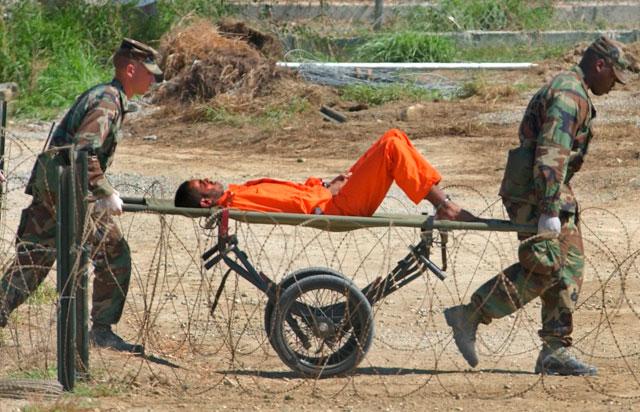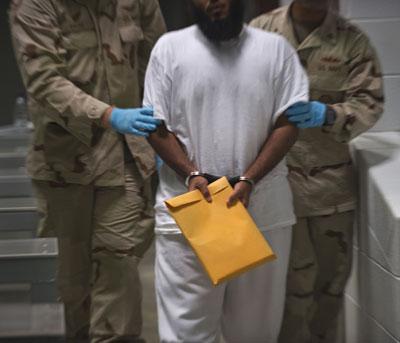You are here
Guantanamo Bay, the infamous jail Obama could not shut
By AFP - Jan 18,2017 - Last updated at Jan 18,2017

In this February 2, 2002 file photo, a detainee from Afghanistan is carried on a stretcher before being interrogated by military officials at the detention facility Camp X-Ray on Guantanamo Bay US Naval Base in Cuba (AP photo)
WASHINGTON — Despite a flurry of last-minute releases from Guantanamo Bay, President Barack Obama is set to fail in his eight-year quest to close the infamous military detention centre.
One of his first acts as president in 2009 was to issue an executive order to shut the controversial jail within a year, but it is clear it will remain open when he leaves office on Friday.
“I don’t anticipate that we will succeed in that goal of closing the prison, but it’s not for a lack of trying,” White House Press Secretary Josh Earnest told his final media briefing on Tuesday.
Obama’s successor, President-elect Donald Trump, has vowed not just to keep Guantanamo open, but to boost the number of terror suspects housed there — even raising the prospect of US citizens being sent to the facility.
“We’re gonna load it up with some bad dudes, believe me, we’re gonna load it up,” Trump said while campaigning last year. He separately said “it would be fine” if US terror suspects were sent there for trial.
On Monday, 10 former detainees — eight Yemenis and two Afghans — were sent to Oman, bringing the remaining Guantanamo population to 45, down from 242 when Obama took office.
Several more have been cleared for transfer, and a US official told AFP to expect a “handful” more by Friday — despite Trump’s call this month for “no further releases”.
But dozens of inmates will remain in indefinite detention on day one of the Trump presidency.
“President Obama’s legacy on Guantanamo isn’t just about those he transfers, it’s also about those he leaves behind,” Elizabeth Beavers, a senior campaigner with Amnesty International USA, told AFP.
“There is a risk that the prison could become permanent, with those remaining at risk of torture or other ill-treatment.”
Of the 45 men still at Guantanamo, nine are cleared for transfer and another 26 remain in legal limbo — the so-called “forever prisoners” who have not been charged with anything but are deemed too dangerous to release.
The other 10, including the alleged plotters of the September 11, 2001 attacks, are going through a glacially slow military prosecution at Guantanamo.
They are due in a Guantanamo military court next week for yet another pre-trial hearing.
Extremist ‘recruitment tool’
Obama struggled to find a solution to the vexed question of what to do with the forever detainees, and it is uncertain they could be convicted in a civilian court.
The outgoing president had tried to transfer many detainees abroad and bring the most high-value ones to the United States, but funding was blocked by Republicans and even some in his own Democratic Party pushed back against closure plans.
An oft-cited reason for keeping Guantanamo open is the recidivism rate. About 30 per cent of detainees released are suspected or confirmed to have re-engaged against US interests, though the rate dropped sharply among those released under Obama.
Guantanamo first opened in early 2002, hastily erected on a grassy hillside on America’s naval base in Cuba, where detainees would be out of the reach of federal US courts.
The men arrived in orange jumpsuits, shackled and blindfolded — and sometimes were trundled around the outdoor prison camp on gurneys that looked like giant wheelbarrows.
Some had been kidnapped by foes in Afghanistan and sold to the Americans for a bounty, often on the basis of slim or made-up evidence.
The cages they were held in have long since been shut and modern, high-security facilities erected to replace them at a cost of millions of dollars.
Obama repeatedly said the controversial prison served as a “recruitment tool” for terrorist organisations and was a waste of money — it currently costs about $7 million to keep each detainee there per year.
He has laid the blame for Guantanamo’s continued use squarely at lawmakers’ feet.
“I have not been able to close the darn thing because of the congressional restrictions that have been placed on us,” he said last year.
‘For the duration’
Countries receiving former detainees must give guarantees they will be monitored and participate in rehabilitation programmes.
Six former Guantanamo inmates were resettled in Uruguay in 2014, but the men floundered in the Spanish-speaking nation and one went on hunger strike to demand being sent elsewhere.
“They are rebuilding their lives in Uruguay, but among the six, at least five are struggling,” Christian Mirza, who heads the case for the Uruguay government, told AFP.
Retired General James Mattis, who is set to become Trump’s defence secretary, last week said America retains the legal right to capture enemy combatants and hold them as prisoners “for the duration of a war”.
“Long-term detention is appropriate when an unprivileged enemy belligerent poses a continuing significant threat to the security of the United States,” he told lawmakers last week.
But how many new inmates will actually end up in Guantanamo is tough to predict.
Obama widely expanded the use of drones in counterterrorism operations and if US agencies have solid intelligence on a terror suspect, they now tend to simply send a drone to kill him.
Related Articles
GUANTANAMO BAY NAVAL BASE, Cuba — It’s been almost a decade since the last detainee landed at Guantanamo Bay.
DUBAI — Oman said Monday it accepted 10 detainees from the US prison at Guantanamo Bay ahead of President Barack Obama leaving office, part
WASHINGTON — The Pentagon on Monday announced the transfer of two Libyan inmates from the Guantanamo Bay detention centre to Senegal, the la















